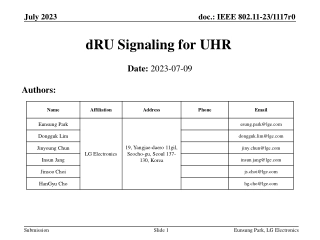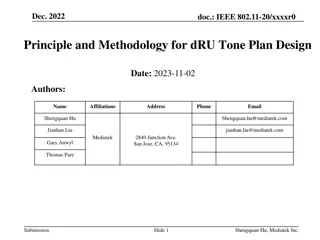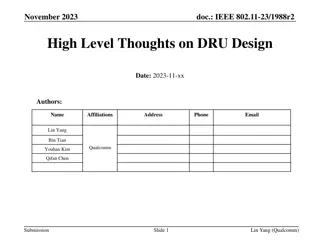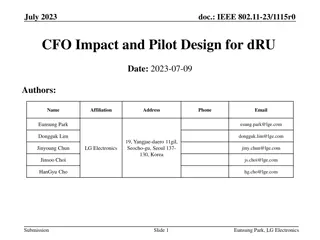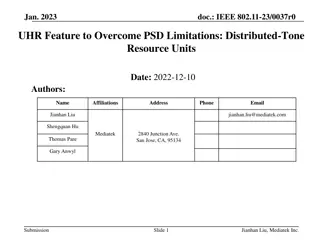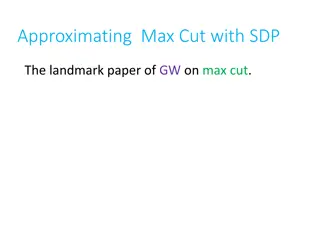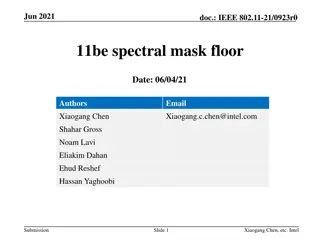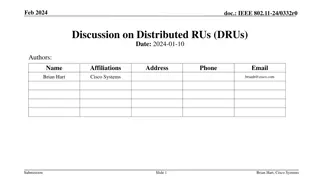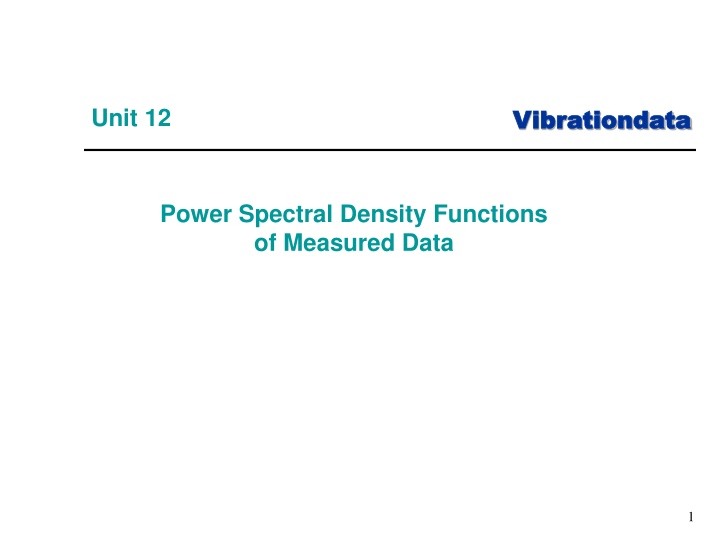
Vibrationdata - Power Spectral Density Functions and Octave Bands
Explore examples of Power Spectral Density calculations using measured and synthesized data. Learn about octave bands and how to convert PSD to one-sixth octave format. Practice PSD calculations with different parameters and visualize the results in linear-linear format images.
Download Presentation

Please find below an Image/Link to download the presentation.
The content on the website is provided AS IS for your information and personal use only. It may not be sold, licensed, or shared on other websites without obtaining consent from the author. If you encounter any issues during the download, it is possible that the publisher has removed the file from their server.
You are allowed to download the files provided on this website for personal or commercial use, subject to the condition that they are used lawfully. All files are the property of their respective owners.
The content on the website is provided AS IS for your information and personal use only. It may not be sold, licensed, or shared on other websites without obtaining consent from the author.
E N D
Presentation Transcript
Vibrationdata Vibrationdata Unit 12 Power Spectral Density Functions of Measured Data 1
Vibrationdata Vibrationdata PSD Examples Practice PSD calculations using both measured and synthesized data 2
Exercise 1 Vibrationdata Vibrationdata Use the vibrationdata GUI script to synthesize a white noise time history with 1 G standard deviation, 10 second duration, and 1000 samples per second, no lowpass filtering. 3
Exercise 1 Vibrationdata Vibrationdata 500 500 Use vibrationdata GUI script to calculate the power spectral density. Choose 512 samples per segment, which corresponds to 38 dof and f = 1.95 Hz. Select the mean removal and Hanning window options 4
Exercise 1 Vibrationdata Vibrationdata 500 Repeat the power spectral density calculation for 128 samples per segment, which corresponds to 156 dof and f = 7.8 Hz. 5
Vibrationdata Vibrationdata Note linear-linear format. The red curve smoothes the data using a wider delta f with higher statistical dof. 6
Vibrationdata Vibrationdata Exercise 2 Octave bands Relationship between two adjacent frequencies is f2 = f1 * 2n Typical n values: 1, 1/3, 1/6, 1/12 The frequency step has a proportional bandwidth which increases as the band center frequency increases. Acoustic Sound Pressure Levels (SPL) typically are in one-third octave format. Piano keys have one-twelfth octave spacing. 7
Vibrationdata Vibrationdata 500 Calculate the PSD of the 10-second white noise time history using only one segment, f = 0.12 Hz, 2 dof Save PSD to Matlab workspace. 8
Vibrationdata Vibrationdata 500 Convert the PSD to one-sixth octave format via: Select Input Data Domain > Power Spectral Density > Convert to Octave Format Note that the PSD of ideal white noise is a flat, horizontal line. 9
Vibrationdata Vibrationdata Exercise 3 Generate pink noise, 10-second duration, std dev=1 Take PSD with one segment. Calculate one-third octave PSD. 10
Vibrationdata Vibrationdata 11
Vibrationdata Vibrationdata The PSD slope is -3 dB/octave 12
Exercise 4 Vibrationdata Vibrationdata Taurus auto with accelerometer mounted in console. 13
Vibrationdata Vibrationdata Calculate PSD using f=0.3 Hz processing case. Identify the spectral peaks. 14
Taurus Auto PSD Vibrationdata Vibrationdata 15
Half-power Bandwidth Points (-3 dB) Vibrationdata Vibrationdata f = (1.9 0.88) Hz = 1.0 Hz Viscous Damping Ratio = f / (2 f ) = 1.0 / (2*1.5) = 0.33 Auto Spring-Mass Frequency is 1.5 Hz with 33% damping (shock absorbers) Interpolation Method: Data Cursor (Right Mouse Click) > Selection Style > Mouse Position 16
Vibrationdata Vibrationdata Automobile Natural Frequencies Fundamental Frequency Vehicle Passenger Car 1 to 1.5 Hz Sports Car 2 to 2.5 Hz Hummer 4.5 Hz 17
Vibrationdata Vibrationdata Tire Imbalance Frequency Assume 25 inch tire outer diameter at 65 mph. Circumference = ( 25 inch ) = 78.5 inch 65 mph = 1144 in/sec ( 1144 in/sec ) / 78.5 in = 14.6 Hz 2X harmonic = 29.1 Hz 18
Exercise 5 Vibrationdata Vibrationdata Generate a white noise time history: Duration = 40 sec Std Dev = 1 Sample Rate=10000 Hz Lowpass Filter at 2500 Hz Save Signal to Matlab Workspace: white_40_input_th 19
Vibrationdata Vibrationdata Base Input Time History: white_40_input_th 20
Exercise 5 (cont) Vibrationdata Vibrationdata Generate the PSD of the 40-second white noise time history Input: white_40_input_th Use case 8 which has f 5 Hz Mean Removal Yes & Hanning Window Plot from 10 to 2000 Hz Save PSD to Matlab Workspace white_40_input_psd 21
Vibrationdata Vibrationdata Base Input PSD: white_40_input_th 22
Vibrationdata Vibrationdata Recall SDOF Subjected to Base Input 23
Vibrationdata Vibrationdata SDOF Response to White Noise Subjected a SDOF System (fn=400 Hz, Q=10) to the 40-second white noise time history. Input: white_40_input_th Use Vibrationdata GUI option: SDOF Response to Base Input Save Acceleration Response time history to Matlab Workspace pick a name 24
Vibrationdata Vibrationdata Response Time History: white_40_response_th 25
Vibrationdata Vibrationdata SDOF Response to White Noise PSD Take a PSD of the Response Time History Input: white_40_response_th Mean Removal Yes & Hanning Window Use case 8 which has f 5 Hz Plot from 10 to 2000 Hz Save Response PSD to Matlab Workspace: white_40_response_psd 26
Vibrationdata Vibrationdata Response PSD: white_40_response_psd 27
Half-power Bandwidth Points (-3 dB) Vibrationdata Vibrationdata f = (415.9 380.2) Hz = 35.7 Hz Viscous Damping Ratio = f / (2 f ) = 35.7/ (2*400) = 0.0446 Q = 1 / ( 2 * 0.0446 ) Q 11 10% higher than true value Q=10 Response PSD: white_40_response_psd 28
Vibrationdata Vibrationdata Plot Both PSDs Go to: Miscellaneous Functions > Plot Utilities Select Input > Two Curves Curve 1: white_40_input_psd Color: Red Legend: Input Curve 2: white_40_response_psd Color: Blue Legend: Response Format: log-log X-axis: 10 to 2000 Hz X-label: Frequency (Hz) Y-label: Accel (G^2/Hz) 29
Vibrationdata Vibrationdata 30

